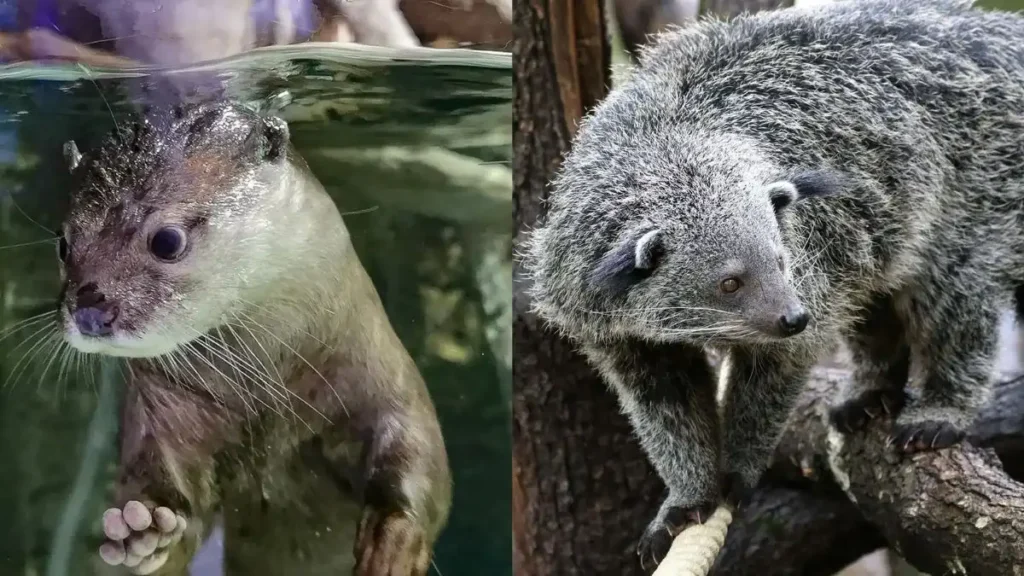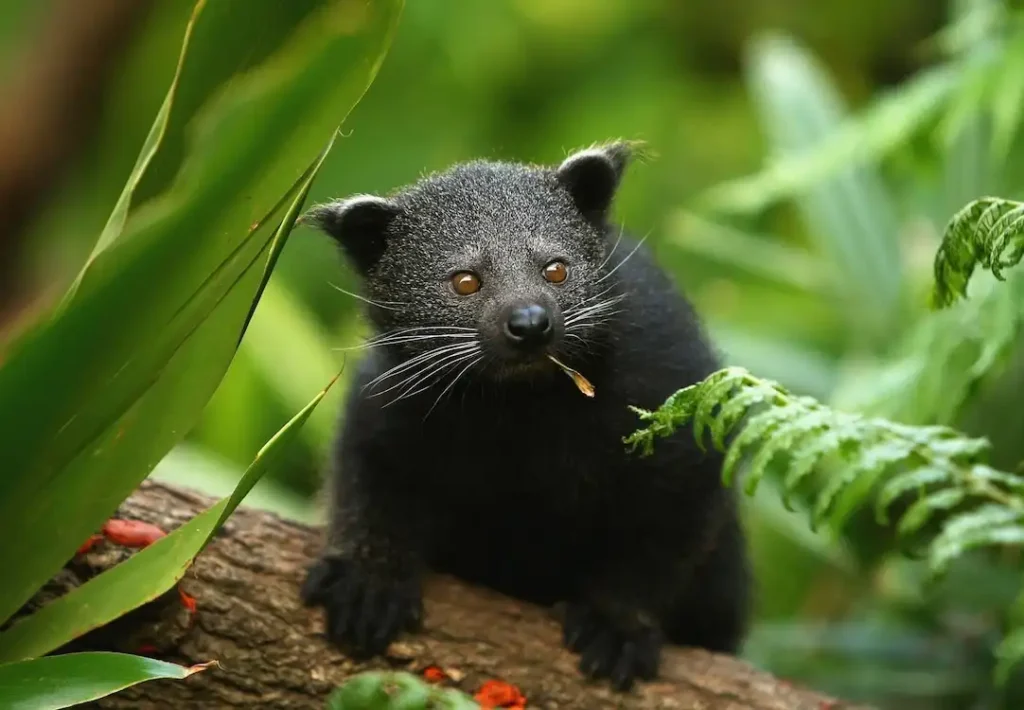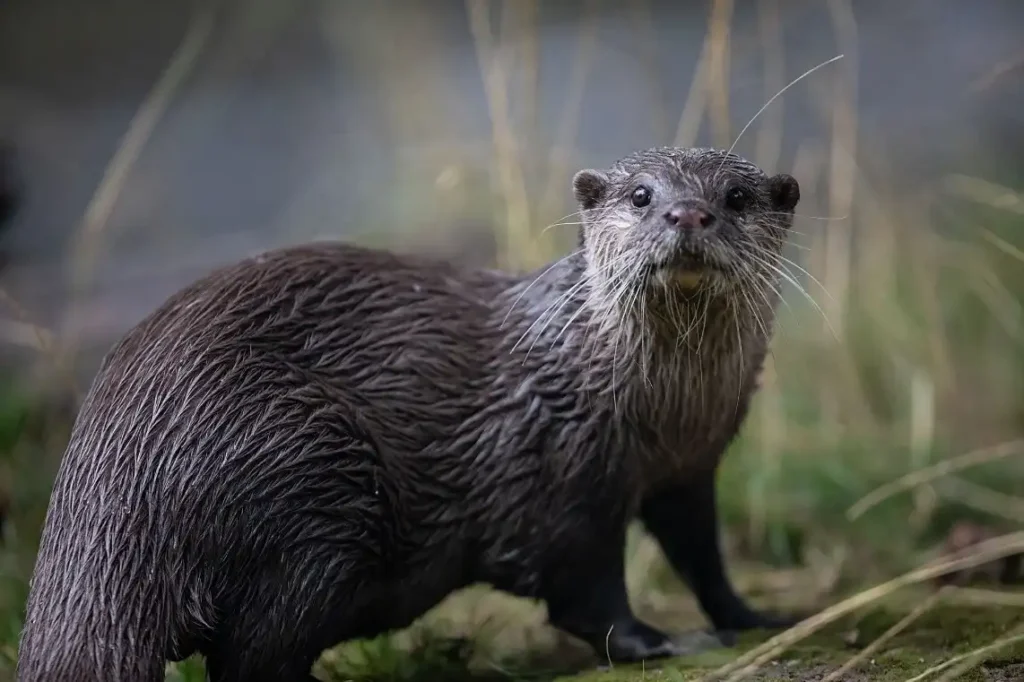The Binturong and Small-clawed otter, two previously undocumented mammalian species, have been discovered in Assam’s Kaziranga National Park and Tiger Reserve.
About the Binturong (Arctictis binturong):
- The Binturong is a nocturnalarborealmammal exclusively distributed to the northeast in India.
- It remains active both during the day and at night.
- It is the largest civet in India, also known as the bearcat.
- Habitat of the binturong is dense tropical rainforests, and it also prefers regions with a thick canopy.
- It is distributed across a range of Southeast Asian countries, including India, Nepal, Bangladesh, Bhutan, Myanmar, Thailand, Malaysia, Laos, Vietnam, Cambodia, and Indonesia.
- It is omnivores, with a diet consisting of fruits, small mammals, birds, and occasionally, insects.
- It plays a crucial role in seed dispersal, aiding in the regeneration of forests by consuming fruits and excreting seeds in different locations.
Physical Characteristics:
- It has long, prehensile tails, which can be as long as their bodies.
- Their shaggy fur is mainly black, with a unique scent gland located near the base of the tail, producing a distinctive musky odour.
Conservation Status:
- IUCN: Vulnerable
- The Wildlife Protection Act 1972: Schedule I
About the Small-Clawed Otter (Aonyx cinereus):
- The Small-Clawed Otter is the world’s smallest otter species, whose distribution range from India to Southeast Asia and southern China.
- In India, it is mostly distributed along the hills of Western Ghats, in regions of Western Himalaya, mangroves of east Calcutta and Sundarbans, Assam, Arunachal Pradesh, and some sites in Odisha.
- It is primarily found in freshwater habitat, including mangrove swamps, rivers, and freshwater wetlands.
- It is primarily carnivorous, feeding on fish, crustaceans, and mollusks.
Physical Characteristics:
- Its distinctive features include short claws and a more streamlined body as compared to other otters.
- It has a flattened head and a short, thick neck; eyes are located toward the front of the head.
- The ears are small and rounded and have a valve-like structure.
- Nose pads are dusky or pinkish in color.
- It is an agile swimmer, as it uses its sensitive fingers to locate prey in murky waters.
Social Behavior:
- It is a highly social animals, and lives in family groups.
- The families work together in hunting and raising their young ones.
Conservation status:
- IUCN: Vulnerable
- CITES: Appendix I
- The Wildlife Protection Act 1972: Schedule I
About the Kaziranga National Park and Tiger Reserve (KNP):
- The KNP is a protected area located in the core area of the Kaziranga-Karbi Anglong of Assam.
- It is a UNESCO World Heritage Site since 1985.
- It was formed in 1908 on the recommendation of Mary Curzon, the wife of Lord Curzon, Viceroy of India.
- It was declared as a Tiger Reserve in 2006.
- It acts as a crucial corridor for wildlife migration between the Eastern Himalayas and the Indo-Malayan region.
- It is drained by 4 major rivers including the Brahmaputra River.
- The type of habitat of Kaziranga is tall elephant grass, alluvial inundated grasslands, alluvial savanna woodlands, tropical semi-evergreen forests, marshland, and dense tropical moist broadleaf forests.
- Flora of Kaziranga includes- Aphanamixis polystachya, Talauma hodgsonii, Dillenia indica, Garcinia tinctoria, Ficus rumphii, Cinnamomum bejolghota, etc.
- It is home to the big 5- One-horned rhinoceros, Indian elephant, Bengal tiger, wild water buffalo, and eastern swamp deer.
- It has the largest population, about two third, of the Indian one-horned rhinoceros.
- Other recorded mammals in Kaziranga are- Indian wild boar, Indian gaur, sambar, hoolock gibbon, Gangetic dolphin, capped langur, sloth bear, leo
Ref: Source
| UPSC IAS Preparation Resources | |
| Current Affairs Analysis | Topperspedia |
| GS Shots | Simply Explained |
| Daily Flash Cards | Daily Quiz |





